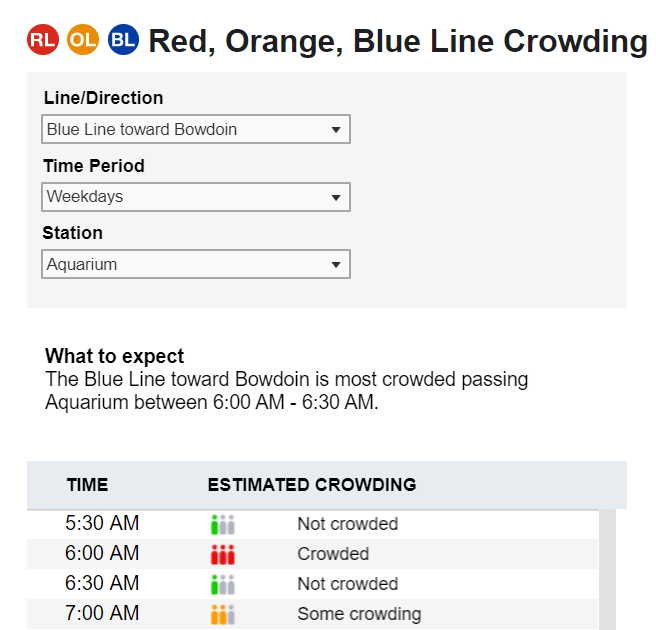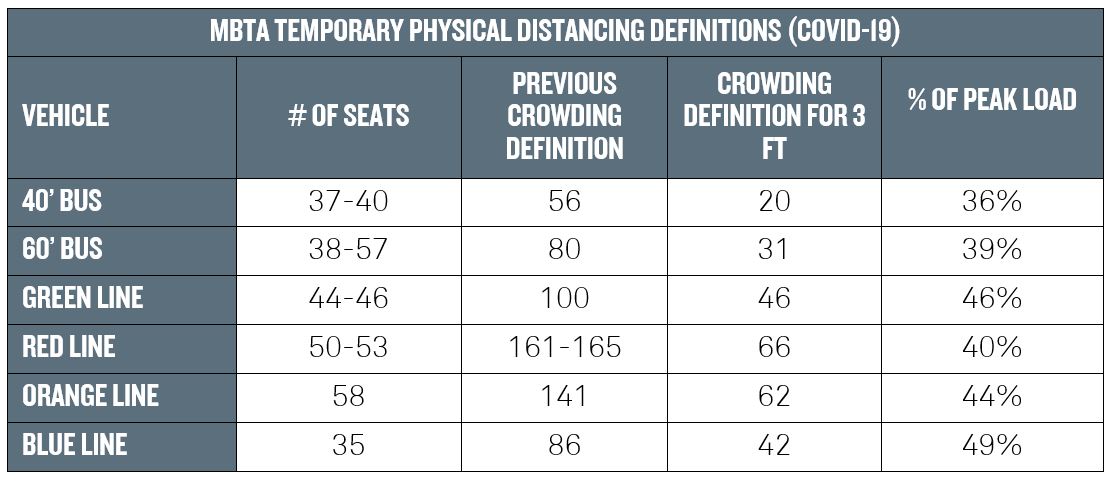Is Your Subway Line Crowded? “Last Week’s” Data is Now Available from the MBTA
October 14, 2020
WRITTEN BY CAITLIN ALLEN-CONNELLY, PROJECT DIRECTOR
Experts tell us that maintaining a safe distance from other riders (a.k.a. physical distancing) during the COVID-19 pandemic is a critical component to staying safe on public transit. But what does that mean exactly? Well, it means ensuring that stations and vehicles carry a limited number of passengers to allow people to spread out.
This past June, the MBTA rolled out a real-time crowding data to monitor ridership along bus routes. The tool lets riders know if their bus is “Crowded,” has Some Crowding,” or, is “Not Crowded”, and it tells them how long they have to wait for the next bus. Together, these features are meant to give commuters some flexibility, if they have it, to avoid traveling on a crowded bus. Some not-so-scientific (but intuitive) analysis shows patterns of crowding that suggest current riders may not be using the crowding app or simply don’t have the flexibility in their commute to hop on the next bus.

In late September, the T expanded their ability to provide crowding information to the Blue, Orange, and Red Lines. The rapid transit cars are not equipped with the APC (automated passenger count)1 technology used on buses; therefore, the T has to rely on historical fare gate taps, i.e. last few weeks, to provide ridership trends and crowding information.2 This data is not available for the Green Line or Mattapan Trolley and can only be accessed on the MBTA website. It informs riders about two things: (1) high-level information on when to expect crowding, and (2) crowding information by ½ hour increments from 5:30AM to 12:30PM.
Upon investigation, the rapid transit crowding function seems to provide information that riders can already assume, i.e. subway will be most crowded during rush hour, and the quick, high-level overview “What to expect” (see figure above) isn’t completely accurate. At least this was the case for the Blue and Orange Lines last week; the “What to expect” section of the website noted 5:30AM-6:00AM as the most crowded times at the Blue Line State Street Station (direction Bowdoin), while the detailed crowding information showed “No Crowding” during those times and “Crowding” from 6:00AM-7:30AM and 11:30AM. The same was true in the evening (direction Wonderland) where expected crowding was shown from 3:30PM-4:00PM and “Some Crowding” was shown in the crowding tool from 4:30PM-5:00 PM, 7:30 PM, and 10:00 PM.
Perhaps the rapid transit crowding tool is still evolving, but as we are all too aware, inaccurate information can cause more harm than good. With ridership increasing and the looming proposed service cuts, having MBTA Ambassadors in stations to help riders spread out would help build confidence in the system. The installation of physical distancing decals in stations and vehicles would, too. The region’s recovery depends on the MBTA’s ability to instill confidence in riders to come back to public transit. A Better City continues to commend the MBTA’s initiative to provide crowding data, and urge them to continue to improve and expedite their delivery of information around crowding, so commuters will return to the T (and not single-occupancy vehicles) when they return to the workplace.
Cheat Sheet: How Many Passengers is Too Many?
SOURCES
1. APC is technology that is installed at the front and rear bus doors and detects when riders get on or off the bus
2. This technology appears to be similar to what some other transit agencies are using, e.g. Chicago CTA
Image Source: www.mbta.com/covid19#crowding





